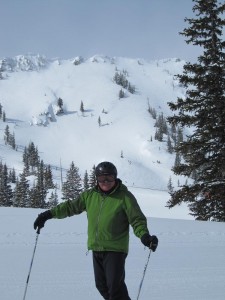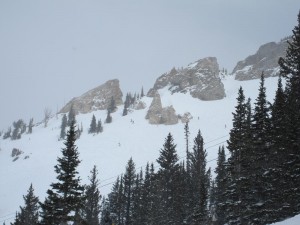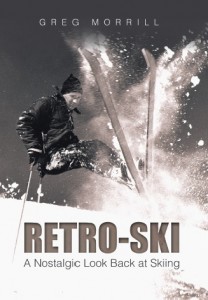
Greg with the East Castle at Alta in background
Alta, Utah, began as a silver mining town in 1865. At its peak in the late 1800’s it had an estimated population of 8000 and about 180 buildings – 26 of which were bars. Apparently the Utah liquor laws were different back in those days.
By the time of the Great Depression the mining boom had dwindled out and most of the buildings had been destroyed by a series of avalanches. However adventurous skiers had begun hiking up Little Cottonwood Canyon to enjoy what is now the Alta ski area. In the winter of 1935-1936 the United States Forest Service retained a professional ski jumper, Alf Engen, to examine potential sites for ski areas and Alta was one of the sites Engen visited. In 1937 based on Engen’s recommendations, the Forest Service obtained surface rights to 1800 acres from George Watson who had purchased most of the mining property in the canyon. (The Watson Shelter is named for him.) The Salt Lake Winter Sports Association raised the money needed to convert an old mining tramway into a chairlift and on January 15, 1939, the original Collins lift went into service.
You may recall that the first chairlift was built at Sun Valley in 1936. In fact, the team that Averell Harriman hired to find a location for his ski area had actually looked at Alta, but chose Sun Valley instead.
In conjunction with the Collins lift, a lodge was built to serve as a warming shelter for Alta day skiers. Initially called the Rock Shelter, it is now called the Snowpine lodge. Stowe Mountain Host Bill Kornrumpf was the first to identify the Snowpine as the oldest of Alta’s lodges and Greg Dirmaier added that Rock Shelter had been its original name.
On my most memorable Alta trip I stayed at the Snowpine Lodge . However it wasn’t the lodge that made the trip memorable, but the snow and the skiing.
It was around the first of March in 1996 when I saved the company some airfare by extending a business trip to ski several days at Alta. It snowed every day I was there in ever increasing amounts. On my last day I awoke to the welcome thumping of explosive charges. When I went down to breakfast, I learned it was a good-news/bad-news story: twenty one inches of snow overnight, but we were in an Interlodge. An Interlodge is when you are not allowed outside of your lodge until avalanche danger is deemed safe.
Breakfast became a more laidback affair with many tales of Interlodges past. Maybe because this was my first Interlodge, I was a little more vigilant than most about when it was lifted. I was the second one out of the lodge.
The Snowpine is located above the Alta lift area so your first run of the day is down to the lift. That gave me my first taste of the new snow. This wasn’t the light blower powder for which Alta is famous. It was a denser snow and you actually ended up skiing almost on top of it. Still, turning was pretty easy.
Now another thing that made this trip memorable was that I had the good fortune to meet a group of Stowe regulars anchored by Craig Echo who knew Alta inside-and-out. They had dragged me places I would never have found skiing alone. It took me a couple of runs on that last powder day to catch up with them (they were staying at the Peruvian), but once again we found ample runs with untracked snow.
I had been to Alta quite a few times dating back to the early 1970’s, but I was not an “Altaholic”. I felt there was too much traversing and hiking; however this trip converted me. Combining great snow with a group that knew how to take advantage of the hiking and traversing made me a believer.

High Traverse at Alta
At 4:29 on that last afternoon I caught the Germania chairlift for one last solo run. I hiked up to the High Traverse and took it all the way past Alf’s High Rustler into Eagle’s Nest. Lower down where the trees become sparser there were still untracked lines to be skied.
I was the last one back to the Snowpine that afternoon.

Leave a Reply